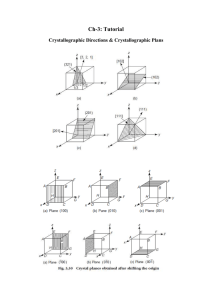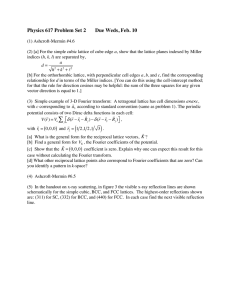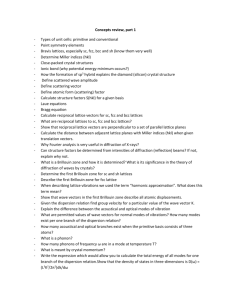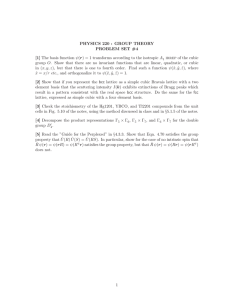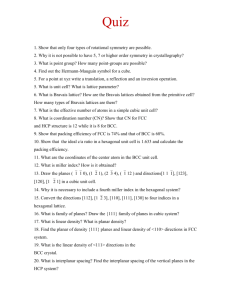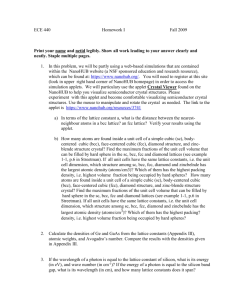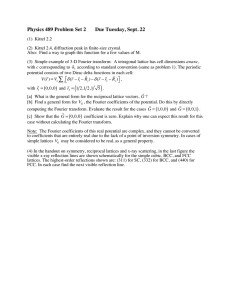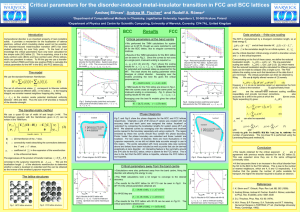Critical parameters for the Anderson transition in BCC and FCC lattices
advertisement
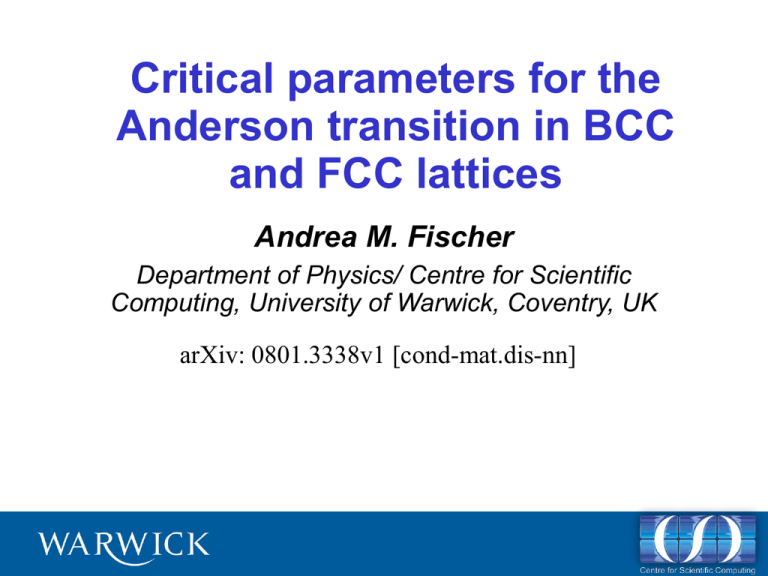
Critical parameters for the Anderson transition in BCC and FCC lattices Andrea M. Fischer Department of Physics/ Centre for Scientific Computing, University of Warwick, Coventry, UK arXiv: 0801.3338v1 [cond-mat.dis-nn] Where is Warwick? -founded 1965 -17,000 students -5000 staff -57th worldwide THES 2007 -5th nationally in RAE Perfect Crystalline Solids • Non-interacting electrons in a periodic potential - Bloch electrons nk r unk r e ik.r infinite conductivity of metals!? Felix Bloch electron Fermi energy periodic potential Real Crystalline Solids • Real crystalline materials contain vacancies and impurity atoms disorder • Electron-electron interactions can also be important, although these are shielded and this depends on the electron density • Ions are not fixed, but vibrate about their mean positions – avoid by going to low temperatures (< 10K) electron Fermi energy random potential The Anderson Transition • At a certain critical disorder there is a transition between metallic and insulating states - the Anderson transition [P.W. Anderson, Phys. Rev. 109, 1492 (1958)] • Can think of it as a second order phase transition • An entirely quantum mechanical effect that controls macroscopic, measurable properties of the system!! i.e. resistance Philip Anderson Mechanism for Localisation • Localisation due to quantum interference of scattered electron wavefunction • Also occurs for classical waves e.g. water waves regular array of scatterers disordered array of scatterers [P.E. Lindelof, J. Noregaard and I. Hanberg, Phys. Scr. T14 17] Distinguishing between metallic and insulating states Experimentalist - resistivity T • metal: T increases with increasing T • Insulator: T decreases with increasing T T Theoretician - localisation length • metal: increases as a function of system size • insulator: decreases as a function of system size r f r e insulator metal T [M.P. Sarachik and S.V. Kravchenko, Proc. Natl. Acad. Sci. U.S.A. 96, 5900 (1999)] r Anderson Model • Anderson Hamiltonian H i i i tij i j i j i potential energy • Electronic wavefunction i i i hopping term Anderson model • No disorder in hopping term, nearest neighbour hopping only i.e. • Consider case of uniform disorder in the onsite potential energy P i 1 j i 1, j i 1 tij 0 otherwise 1 W i W 2 W 2 • Under these conditions get lattice Schrödinger equation for SC lattice H l l 1 l 1 E l ( 2) l Outline • Anderson transition has been studied extensively for SC lattice • study the more complex BCC and FCC lattices, which are more common in nature – involves introduction of connectivity matrices • transfer-matrix method to obtain localisation lengths as a function of system size, energy and disorder • finite-size scaling to analyse data and find the critical disorders, energies and exponents • show that BCC and FCC lattices are in the same universality class as the SC lattice Transfer-matrix method (TMM) • Model a 3D system as a quasi-1D bar of cross-sectional area M x M and length N, where N >> M. M • Re-write lattice Schrödinger equation: M l 1 E1 H l 1 l Tl 0 l 1 l 1 N • Lyapunov exponents obtained from eigenvalues of transfer matrix 1 1 l Tl Tl 1...T1 [V.I. Oseledec, Trans. Moscow. Math. Soc. 19, 197 (1968)] • Localisation length obtained as inverse of smallest Lyapunov exponent M , E ,W 1 min , reduced localisation length M E , W M , E ,W M What about other lattice structures? • Hopping terms in the 2D Hamiltonian representing in-layer connections are different and depend on boundary conditions • connectivity matrices Cl describe the connections between layers l-1 and l: (Cl)ij=1 if sites i and j are connected and 0 otherwise Cl11 E1 H l Cl11Cl Tl 1 0 • Challenge: choose boundary conditions, system sizes and lattice planes so connectivity matrices are non-singular Example of connections resulting in a singular connectivity matrix 1 12 1 2D 23 12 34 23 4 34 4 1 0 0 1 1 1 0 0 SINGULAR! 0 1 1 0 0 0 1 1 • M=4, periodic boundary conditions SINGULAR • M=4, hard wall boundary conditions NON-SINGULAR • M=3, periodic boundary conditions NON-SINGULAR BCC and FCC lattice structures Body centred cubic • 8 nearest neighbours, 0 in-plane and 4 in each nearest neighbour plane • TMM direction: <100> Face centred cubic • 12 nearest neighbours, 6 in-plane and 3 in each nearest neighbour plane • TMM direction: <111> i.e. close packed planes Phase diagrams BCC FCC dashed lines = theoretical band edges Z W / 2 dotted lines = analytical estimation for critical disorder based on self-consistent theory of localisation [E. Kotov and M. Sadovskii, Z. Phys. B 51, 17 (1983)] Creation of phase diagrams BCC FCC W W -E -E • Grid of E-W points with separation 0.5 • Extended (red) 7 9 , localised (green) 7 9 • Average over 3 outermost points separately for extended and localised regions to get two boundaries • Do a spline fit for these points Symmetry of phase diagrams • BCC phase diagram symmetric about E=0, whereas FCC lattice is not • Reason: BCC lattice bipartite, FCC lattice not • Bipartite: A lattice is bipartite if it can be split into 2 sublattices s.t. for a site on one sublattice all its nearest neighbours are on the other sublattice. • Why does bipartiteness result in symmetry? H E THT 1T ET , where h11 h12 h22 h THT 1 21 h h32 31 HT ET h13 h23 h33 1 1 T 1 bipartite transformation ... ... H bipartite lattice, zero disorder ... H bipartite lattice, disorder TMM results for E=0 BCC FCC • Colours represent different system sizes M=3,…,15 • Error bars within symbol size • Lines are fits obtained using finite size scaling Finite-Size Scaling (FSS) • The Anderson transition is characterised by a divergent correlation length in the thermodynamic limit W W Wc E E Ec for fixed energy E and for fixed disorder W, where is the critical exponent • Main idea is one-parameter scaling hypothesis M f E , W , M f M E ,W M f r M 1/ , i M y , ~ • A better fit can be obtained by using where r and i are the relevant and irrelevant scaling variables respectively, y < 0. Finite-Size Scaling (FSS) • Proceed via a Taylor expansion ni M M n 0 n i ny ~ fn r M 1 , ~ f n ani M • Include non-linear dependence on W, mr r (w) bn wn , n 1 nr i 0 i r 1 mi i ( w) cn wn n 0 where w=(Wc-W)/W • Aim: to obtain the best fit whilst keeping no. of parameters reasonably small no. params = (ni+1)(nr+1)+mr+mi+1(or 2) • Non-linear fit performed using Levenberg-Marquardt method Scaled localisation lengths for FCC lattice, W=18 M=9,11,13,15 metallic insulating FSS Scaling parameter for BCC lattice, W=17.5 r E r E r E 1.45 BCC results (b) • All errors are standard errors • (a) 91 data points, 41 best fit models • (b) 108 data points, 8 best fit models • Compare to 1.57 0.02 found for SC lattice using similar numerical techniques. [K. Slevin and T. Ohtsuki, Phys. Rev. Lett. 82, 382 (1999)] FCC results at barycentre (E=0) • 91 data points, 31 best fit models • No irrelevant scaling necessary FCC results for W=18 q • 83 data points, 8 best fit models • Good q values • = no. of degrees of freedom = no. of data points – no. of parameters 2 • indicates a good fit Conclusions • 1.5 in agreement with previous results confirming that the BCC and FCC lattices are in the same universality class as the SC lattice • The critical disorder values are non-universal and increase with increasing no. of nearest neighbours • Agreement with results of classical site and bond percolation models for SC, BCC and FCC lattices For more details please see [S. Galam and A. Mauger, Phys. Rev. E arXiv: 0801.3338v1 [cond53, 2177 (1996)] mat.dis-nn] Thanks Rudolf A. Römer Andrzej Eilmes • The work was carried out in collaboration with Andrzej Eilmes (Jagiellonian University, Krakow, Poland) and my PhD supervisor, Rudolf A. Römer (University of Warwick, Coventry, UK). • We are grateful to Tom Wright for producing the M=7 and M=9 data used in the phase diagrams. • We acknowledge funding from the EPSRC. Aharonov-Bohm effect for an interacting system •AB effect: Energy of a charged particle in a ring oscillates as a function of perpendicular magnetic flux •Look at AB effect for neutral exciton in a nanoring with perpendicular magnetic field and in-plane electric field Electric field •Electric field destroys translational symmetry of Schrödinger equation so can’t solve exactly What happens to amplitude of oscillation? Oscillation amplitude versus electric field for different interaction strengths Excitonic Wavefunctions Magnetic flux Electric field
